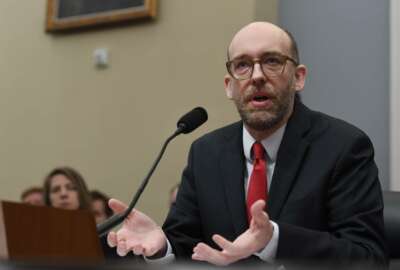
State and local minimum wage bumps don’t apply to feds, OPM says
As several states and local governments have raised their minimum wages well past the federal rate of $7.25 in recent years, the Office of Personnel Management said...
State and local minimum wage rates don’t apply to federal employees, the Office of Personnel Management clarified in new guidance given to agencies this week.
The topic warrants additional clarification, OPM said, as more and more state and local governments have set minimum wages that exceed the federal rate of $7.25. OPM said it has received several questions about minimum wage rates and how they might apply to federal employees who work in various states across the country.
Federal employees are covered under the Fair Labor Standards Act (FLSA), which set the current federal minimum wage at $7.25 in 2009.
State and local government minimum wages aren’t binding on the federal government, OPM said, because federal law supersedes conflicting state laws — according to the supremacy clause of the U.S. constitution.
The FLSA minimum wage generally applies to federal employees unless they’re exempt from certain wage requirements, OPM said. Employees who, for example, meet specific executive, administrative or professional criteria, as well as certain criminal investigators, IT specialists and border patrol agents, are exempt.
But most federal employees are, generally, paid at a rate that exceeds the federal minimum wage.
A GS-1, step 1 employee received a base hourly wage of $9.13 in 2019, not including locality pay. A federal employee at the same grade level who works in a region with the lowest locality pay rate received an hourly wage of $10.56 in 2019, according to OPM.
A GS-1, step 1 employee in the Washington/Baltimore/Arlington, Virginia, locality pay area made $11.80 an hour in 2019. As of July, the minimum wage in Maryland was $10.10 an hour, $14 an hour in Washington, D.C., and $8.75 in West Virginia. Virginia has the federal minimum wage of $7.25.
Employees in Hawaii made an hourly wage of $10.86, just above the state’s $10.10 minimum wage.
Similar employees in San Jose/San Francisco/Oakland, California, made $12.81 an hour in 2019, above the state minimum wage.
There are, however, a few exceptions where a few federal employees in certain locality pay areas may make less than their state’s minimum wage.
A GS-1, step 1 employee in Burlington, Vermont, for example, made $10.60 an hour in 2019, 18 cents less than the state’s minimum wage of $10.78.
The same may be true for a GS-1, step 1 employee in Seattle or Tacoma, Washington, who made $11.50 an hour in 2019. Washington’s minimum wage was $12 an hour as of July.
In New York, location makes all the difference. A GS-1, step 1 in the Albany, New York, locality pay area made $10.70 an hour this year, 40 cents below the state minimum wage of $11.10 an hour.
A similar employee in Buffalo, New York, made $10.92 an hour this year, close but still below the state’s minimum wage. Employees in the Newark, New Jersey/New York, New York locality pay area made $12.14 in 2019, above both the minimum wages for both states.
Some local legislatures have passed their own, higher minimum wages. The minimum rate in Austin, Texas, is $15. A GS-1, step 1 employee in Austin, however, made $10.72 an hour in 2019.
There are similar, slight discrepancies for federal employees who work in Colorado and California, where state minimum wages are $11.10 and $12 an hour, respectively.
In Sacramento, California, a GS-1, step 1 made $11.46 in 2019, about 50 cents below the state minimum wage.
Several states are planning gradual increases in minimum wage over the next few years based on a set formula.
And further planned minimum wage increases may also make these comparisons more complicated in the coming years, especially if the current or future administrations implement small or no pay raises for General Schedule employees.
The Maryland state legislature, for example, voted this year to gradually raise the minimum wage to $15 an hour by 2024. New Jersey and Illinois have similar minimum wage plans over the next five to six years, according to the National Conference of State Legislatures.
To date, 29 states and the District of Columbia have minimum wage rates that are higher than the federal wage, according to the Labor Department. Sixteen others have wages that are equal to the federal rate.
Though minimum wage increases are often decided by state and local legislatures or a ballot measure, federal statute sets pay for General Schedule employees.
Congress would need to pass some sort of statutory change to apply state and local minimum wages to General Schedule pay rates. And OPM doesn’t have the authority to allow state or local minimum wages to supersede GS rates, the agency said.
OPM has required agencies to pay new state or local minimum wages to certain blue collar federal employees covered under the Federal Wage System.
“Under this regulation, the highest state or local minimum wage in effect in the local wage area is applied in setting wage schedule rates unless there is a higher FLSA minimum wage under federal law,” OPM’s guidance reads. “In other words, if there are multiple state or local minimum wages in effect in different jurisdictions encompassed within the same local wage area, the highest minimum wage will be used in setting wage schedule rates for the entire local wage area, if that minimum wage rate exceeds the FLSA minimum wage rate.”
The Federal Wage System, which applies to trade, craft and laboring employees, ensures these individuals who perform similar kinds of work in a common geographic area receive the same hourly wage.
Copyright © 2024 Federal News Network. All rights reserved. This website is not intended for users located within the European Economic Area.
Nicole Ogrysko is a reporter for Federal News Network focusing on the federal workforce and federal pay and benefits.
Follow @nogryskoWFED
Related Stories




